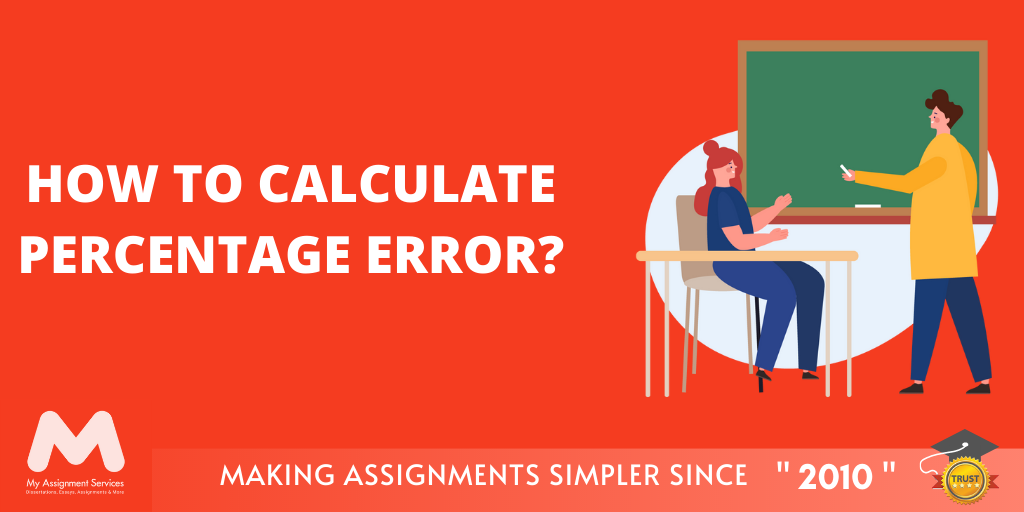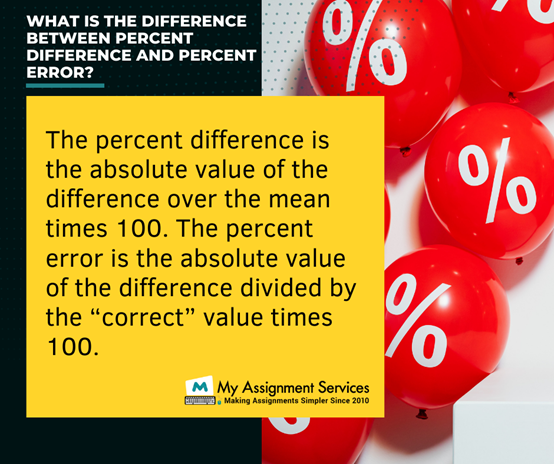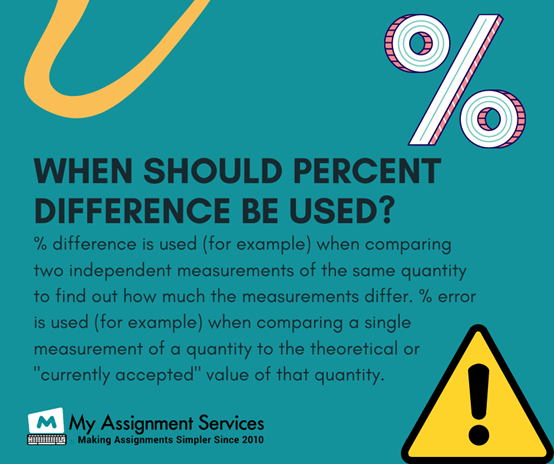
Percent Error is used to find out how much the result of an experiment has deviated from the accepted or standard value. The number below the accepted or standard value is considered 1% less than that actual value, while the other number above it is 1% more. Percent error tells you the extent of accurate results obtained from an experiment. It is also known as percentage inaccuracy or relative error. In percent error, the absolute difference between experimental and accepted values is divided by the exact non-zero accepted value and multiplied by 100 to get a percentage error.
Percent Error can be used in any situation with data where information about accuracy is desired, for example, measuring prices at a store with a known price list etc. Calculating percent error is an essential skill in many scientific disciplines here. Let's find out how to calculate percent error.

Let's take an example to calculate the percent error equation.
The weight of a chocolate bar was measured as 10 gm, but later it was found that the correct weight of the chocolate bar is 9 gm. Find out what portion of 10 grams this difference represents?
It can be written as: |weight (g) - actual (g)| / perfect (g) * 100% = percentage error
Weight (gm) = 10; actual (gm) = 9; perfect (gm) = 10
|weight (g)-actual(g)|=1 |10-9|=1/10*100=10% error. So the answer would be 1%.
How To Calculate Percent Error From Mean?
The formula for deriving percent error from mean is
percent error = ((observed value - mean) / standard deviation) * 100
where, observed value - the result of the actual experiment. And, the standard deviation is defined as the square root of your variance. If your data set has an even number of observations, then use the average observation to find the mean.
If you are given a problem in which you have to calculate percent error using only one variable, you need to take its natural logarithm and divide it by vice versa. For example, if N represents the negative nth roots of X, then base X equals 10. This makes Y equal 1 divided by N. You can now bring Y back to the normal scale and divide it by vise versa.
For example, if N = -3rd root of X, then base X equals 10. This makes Y equal 1 divided by N = 1/N1/3. Bring the result back to the original scale and divide it by vise versa:
%error=(observed value – mean)/standard deviation*100= y/v/(10-x) * 100%.
You will get a positive percent error in case your experimental value is less than the standard or accepted value. On the other hand, you will get a negative percent error in case your experimental value is more than the standard or accepted value.
For example, if a student scored 70 marks in an exam and the desired score is 80, the percent error will be: %error=(70-80)/80*100 = -10/80 * 100%=-12.5%. This means that he is 12.5% less than expected. Percent Error can be understood with an analogy of simple interest calculation when two numbers are given; rate and time period, where one number (experimental value) is the principle which has to be multiplied by the rate per time period (percentage difference), while the other number (standard or accepted value) is like compound interest which includes both multiplying and adding process, i.e., we add it to our experimental value for finding out the final result.
How to Calculate Percent Error from the Mean of a Normal Distribution?
% error = (observed value – mean) / standard deviation * 100= z/v/(10-x) * 100%. where, observed value - the result of the actual experiment. And the standard deviation is defined as the square root of your variance. If your data set has an even number of observations, then use the average observation to find the mean. If you are given a problem in which you have to calculate percent error using only one variable, you need to take its natural logarithm and divide it by vice versa. For example, if N represents the negative nth roots of X, then base X equals 10. This makes Y equal 1 divided by N. You can now bring Y back to the normal scale and divide it by vise versa:
%error=(observed value – mean)/standard deviation*100= ln(y/v/(10-x))*100%.
Our finance assignment help mentors give an example: an experimenter finds that the percent of the oxygen in a certain amount of water is 20%, but he knows that that should be 24%, so his experimental error is 4% (the difference between actual and accepted values). Since 100% equals 24/20 x 100 = 12, he has an "absolute error" of 4%. If you want to find what portion this represents in the total, take the ratio of the absolute error to the total (12/24) and multiply by 100 to get the "relative error", which is 50% in this case.

It can be seen that percent error (PE) appears as a part of relative error (RE). It is always difficult for students to calculate both PE and RE. So it is better for them if they try to memorise the formula given above. Also, PE will always appear as a positive number, whereas RE can be either positive or negative depending upon whether the experimental value (x) is more than the standard or accepted value (v).
For example: x=5, v=10; here 5-10= -5 and 10/5=2 ; %error=(observed value mean)/standard deviation*100=-5/-2 x 100%=-25%.
Here, the measured value is more than the standard or accepted value, so RE will be negative. If we change this problem as: x=3; v=10; now 5-3=2 and 10/3 = 3.33; %error=(observed value mean)/standard deviation*100= 2/1 x 100%=200%. Here, the measured value was less than the standard or accepted value, so RE will be positive.
The Bottom Lines
The formula for percent error is as follows: "percent error equals absolute value of the difference between the observed and true values, divided by the true value, multiplied by 100".
The following terms are used in this formula:
- observed value (x) = 7 quarts
- true or accepted value (v) = 8 quarts
- absolute error = 2 Quarts
In real life, there would be a greater chance of making a mistake if you measured something very large. In other words, bigger things have greater uncertainty. To be able to measure smaller quantities more precisely, scientists use the micron, which is one-millionth of a metre. The prefix micro- comes from ancient Greek and means small. This is the smallest unit of measurement for an object that is visible to the unaided eye.
The finance industry is a complex and wide-ranging field. You need an expert to guide you through the intricacies of accounting, taxes, investments and more. Let us provide the finance assignment help guided sessions you need so that you can focus on your own work in this fast-paced business world. Request our services today by filling the form!
Related Study Materials
Our Experts can answer your Assignment questions instantly.
Ask Question0 Comment
Get It Done! Today
1,212,718Orders
4.9/5Rating
5,063Experts













Loved reading this Blog? Share your valuable thoughts in the comment section.
Add comment